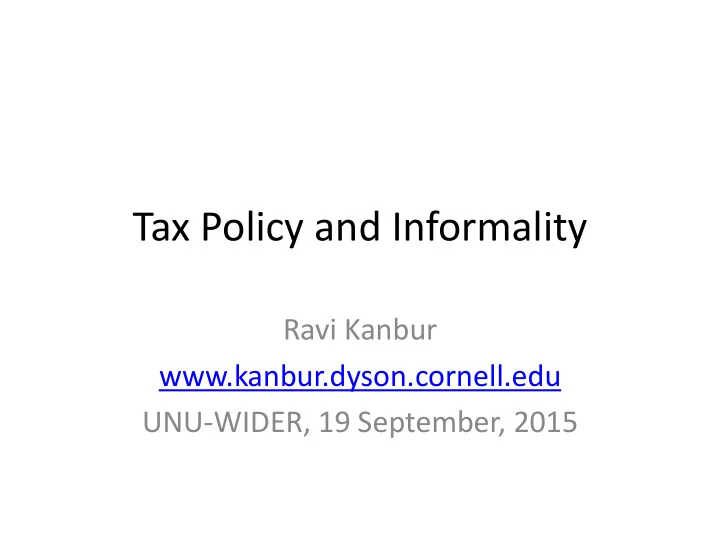

Tax Policy and Informality Ravi Kanbur www.kanbur.dyson.cornell.edu UNU-WIDER, 19 September, 2015
• Ravi Kanbur and Michael Keen: “Thresholds , Informality and Partitions of Compliance.” International Tax and Public Finance, Vol. 21, pp. 536- 559, 2014. • Ravi Kanbur and Michael Keen: “Reducing Informality: It may be a great slogan, but it is of little value as a practical objective for tax reform.” Finance and Development, March, 2015. • Ravi Kanbur and Michael Keen: “Rethinking Informality.” Vox EU, June 2015, http://www.voxeu.org/article/rethinking-informality
Tax Policy and Informality (1) • “Informality” is almost always at or near the top of lists of tax challenges in developing countries. “Taxing the informal economy” leads the African Development Bank’s tax priorities. • “Reducing informality” Is often seen as a central objective of tax reform. But what exactly does this mean, and (once that has been worked out) is it a useful guide to policy?
Tax Policy and Informality (2) • In so far as any precise meaning is given to the term in discussions of taxation, “informality” is usually taken simply to mean non- remittance of tax due — failure to pay. • But there all kinds of reasons why a firm or individual might pay no tax. Maybe they are simply below the threshold (of size, or income) above which they are legally obliged to; or maybe they are evading.
Tax Policy and Informality (3) • Might not why no tax is paid matter for policy making at least as much as the fact of it not being paid? • And how should tax systems be structured when it is recognized that their design may affect not only how much tax is paid, but the different ways in which it is not paid? • These questions lead, in our view, to a more useful strand of analysis than generalities about aggregate informality and objectives of reducing informality.
Tax Policy and Informality (4) • Consider for example the VAT. In almost all countries, this has some threshold level of sales above which the enterprise pays a fixed rate of tax on all of its sales (including those below the threshold). In addition it faces some fixed compliance costs in paying tax. • Firms differ, suppose, in the maximum amount they can sell, though they can choose to sell less than that. They can also choose to pay less than the amount due on their true sales, but there is some cost to them--potential penalties and maybe others too-if they do so. • Within this setting, a few reasonable assumptions imply that firms will plausibly fall into five categories, ranging from the smallest to the largest in pre-tax sales (the mathematical details are in Kanbur and Keen (2014)).
Tax Policy and Informality (5) Label Size by Pre-tax sales and Response to tax Microenterprises Smallest of all; below the tax threshold so tax does not apply Adjusters Next size up; adjust by lowering sales to just below the tax threshold Ghosts Next size up; not pay any tax at all Partial Evaders Next size up; under declare sales to evade taxation partially Compliers Largest firms — full declaration of sales and remittance of tax
Tax Policy Informality (6) • By definition, the formal enterprises are those who are complying. The other four categories are all informal — but each is informal in its own way and will respond to policy differently.
Tax Policy Informality (7) • Consider the key policy choice of setting the tax threshold with the objective of improving social welfare, defined in the usual way as private net of tax income plus government revenue with a weight reflecting the marginal social value of tax revenue. • We show that changing the threshold does not change the measured aggregate informality, but does change welfare because of its effect on the composition of informality.
Tax Policy and Informality (8) • Juxtaposition of labor regulation and tax policy raises the important question of how we think about informality when there are multiple sets of regulations. • What is informality then? Informal relative to either, or both? And how does optimal policy response in one dimension of regulation depend on the situation in the other dimension? • Kanbur and Keen (2014) show that answers to these questions are possible, but have little to do with “reducing informality.”
Conclusion (1) • “Informality” is not going away anytime soon. • The term “informality” is not going away from the analytical and policy discourse either. • However, it is important to be clear about concept and definition, especially in the context of policy. • An aggregative concept and measure of informality captures some aspects of reality, but obscures more than it reveals.
Conclusion (2) • Much of the interesting positive and normative analysis lies in the composition of informality. • For policy, an objective like “reducing informality” does not necessarily emerge as an intermediate indicator corresponding to an underlying social welfare function. • In fact, such an intermediate goal can mislead and obscure. Far better to think directly about objectives, instruments and outcomes. If intermediate targets are needed, they are more likely to emerge from the composition of informality rather than an aggregate.
Thank You!
Recommend
More recommend